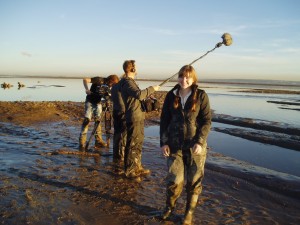 From November 21st -25th 2014 a small team from the University of Reading Archaeology Department took advantage of a low tide to investigate Mesolithic sites in the intertidal zone at Goldcliff, South Wales where many archaeological discoveries have been made over the last 24 years. We found human, bird and deer footprints, Mesolithic flints and charred hazel nuts. The fieldwork was in conjunction with a team from the BBC Horizon Science Series for a programme on the Mesolithic which will be screened in early 2015.
From November 21st -25th 2014 a small team from the University of Reading Archaeology Department took advantage of a low tide to investigate Mesolithic sites in the intertidal zone at Goldcliff, South Wales where many archaeological discoveries have been made over the last 24 years. We found human, bird and deer footprints, Mesolithic flints and charred hazel nuts. The fieldwork was in conjunction with a team from the BBC Horizon Science Series for a programme on the Mesolithic which will be screened in early 2015.
This was the start of a 3 year PhD project by Kirsten Barr who will be looking at Mesolithic, human, animal and bird footprints in the Severn Estuary and elsewhere in order to develop new techniques for the rapid and accurate recording and interpretation of this footprint evidence which is increasingly being found particularly in coastal locations.
Kirsten graduated with a First Class degree in Archaeology from the University of Reading. She started off with a mainly arts focus but discovered an aptitude for science during her  undergraduate degree. After this she did a MSc in Forensic Archaeology at University College, London and her current PhD project has been funded by the Arts and Humanities Research Council. Fieldwork with the BBC team provided an early opportunity in the second month of her project to get information about the project out to the public.
undergraduate degree. After this she did a MSc in Forensic Archaeology at University College, London and her current PhD project has been funded by the Arts and Humanities Research Council. Fieldwork with the BBC team provided an early opportunity in the second month of her project to get information about the project out to the public.
Severn Estuary Prehistoric research is led by Professor Martin Bell, who has published 3 monographs on the subject in the last 14 years. The most recent is The Bronze Age in the Severn Estuary published by the Council for British Archaeology in 2013. This monograph includes contributions by several Reading University students including Kirsten who did her undergraduate dissertation on the footprints of animals in Bronze Age sites.

RT @UniRdg_Arch: Check out our post on Mesolithic fieldwork in South Wales, filmed by BBC for a #Horizon programme airing early 2015! http:…